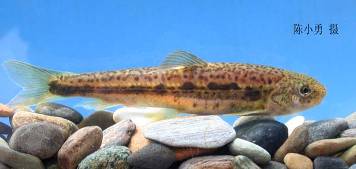
Gymnodiptychus integrigymnatus is a critically endangered species endemic to the Gaoligongshan Mountains. It was thought to be only distributed in several headwater-streams of the Longchuanjiang River (west slope of the Gaoligongshan Mountains, belonging to the Irrawaddy River drainage). It was listed in Chinese Red List as critically endangered species. From 1998 to 2008, the Kunming Institute of Zoology (KIZ), and the Chinese Academy of Sciences, associated with the California Academy of Sciences (CAS) conducted a field survey of the fishes of the Gaoligongshan Mountains. In 2003, 2004 and 2006, dozens of specimens of G. integrigymnatus were collected from nine different sites representing two different river drainages (the Irrawaddy drainage and the Salween drainage). The individuals collected in the Salween drainage are a newly discovered population of G. integrigymnatus.
Morphological and genetic analyses (based on cytochrome b and D-loop) of the newly discovered populations of G. integrigymnatus to determine whether the degree of separation of these populations warrants species status. Analysis from the cytochrome b gene revealed that nine individuals from the Irrawaddy drainage area and seven individuals from the Salween drainage area each have only one unique haplotype. The genetic distance between the two haplotypes is 1.97 %. Phylogenetic analysis revealed that G. integrigymnatus is closely related to highly specialized schizothoracine fishes. Analysis from the mitochondrial control region revealed that G. integrigymnatus has relatively high genetic diversity (π was 0.00891 and h was 0.8714), and individuals from different river drainages do not share the same haplotypes. The AMOVA results indicated 87.27 % genetic variability between the Salween and Irrawaddy populations. Phylogenetic trees show two major geographic groups corresponding to the river systems. It was suggested that G. integrigymnatus should be considered as a high priority for protected species status in the Gaoligongshan Mountains National Nature Reserve, and that the area of the Gaoligongshan Mountains National Nature Reserve should be expanded to cover the entire distribution of G. integrigymnatus. Populations of G. integrigymnatus from different river systems should be treated as evolutionarily significant units. More works on the ecology and reproduction biology of the species should be conducted in future.
For more information, see the paper: Yang Jian, Chen Xiaoyong and Yang Junxing (2010). Molecular and morphological analysis of endangered species Gymnodiptychus integrigymnatus (Teleostei: Cyprinidae). Environmental Biology of Fishes 88 (2), 189–199. DOI: 10.1007/s10641-010-9629-6
